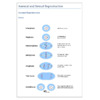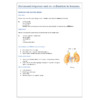|
|
Search Resources (53 Results)
 |
|
Outline | Approved: A year ago | 2.17 MB | Comments: 0
...kingdoms – animals, plants, fungi, protists, &...
...kingdoms of animals, plants, & fungi. They...
...of years before plants & animals appeared....
...such as terrestrial plants & algae. The...
...related to animals, plants, & fungi than...
...infect animals or plants. A parasite is...
...well as animals, plants, & fungi. These...
...pathogens prey on plants, affecting the massive...
...parasites of terrestrial plants include agents that...
...viticola parasitizes grape plants, causing a disease...
...downy mildew. Grape plants infected with P....
...to animals than plants. Fungi are not...
...serious infections in plants & animals. In...
...is used by plants. Chitin, also found...
...as found in plants. Fungi are mostly...
...they are not plants. Dermatophytes are also...
...of leaves from plants & pile them...
...other animals or plants. The fungus Beauveria...
| N/A |
66
|
Amber Mason Turner
|
 |
|
Lecture Notes | Approved: 6 years ago | 150.92 kB | Comments: 0
...needed Rapid spreading Plants – no need...
...Female – Ovum Plants Male – Pollen...
...develop into adults Plants: Agents of pollination...
...Testis Female: Ovaries Plants Male: Stamens Female:...
...Artificial Propagation of Plants A breeder can...
...Many more new plants can be propagated...
...PROPAGATION OF CROP PLANTS Advantages of asexual...
...Produce genetically identical plants Growth rate, harvest...
...characteristics of their plants SEXUAL PROPAGATION OF...
...PROPAGATION OF CROP PLANTS Advantages of sexual...
...high proportion of plants with characteristics of...
...Many generations of plants are needed to...
...to produce the plants with the best...
| N/A |
152
|
johaneswijaya
|
 |
|
Lecture Notes | Approved: 6 years ago | 46.04 kB | Comments: 0
...stage. In flowering plants the diploid sporophyte...
...Sex of the plants: Monoecious: the plant...
...found on separate plants; flowers imperfect. Hermaphroditic:...
...prevent self-fertilization Some plants can self-fertilize if...
...the stigma. Other plants cannot self-fertilize: these...
...cannot self-fertilize: these plants are self-incompatible. There...
...is characteristic of plants that live in...
...dormancy. In some plants, dormant seeds have...
...germination starts. Desert plants have phenolics compounds...
...the life of plants. Asexual reproduction enables...
...rise to independent plants in time by...
...parent. These new plants are clones of...
...rise to new plants. Vegetative reproduction of...
...Vegetative reproduction of plants is common in...
...characteristics of two plants. The plant that...
...to grow whole plants by culturing small...
...have been selecting plants for their desired...
...is common in plants, and has been...
...transgenic. Genetically modified plants have the potential...
| N/A |
147
|
johaneswijaya
|
 |
|
Lecture Notes | Approved: 6 years ago | 31.52 kB | Comments: 0
Category: Botany | Downloaded: 0
...EVOLUTION OF SEED PLANTS Introduction The evolution...
...The evolution of plants is highlighted by...
...and angiosperms, the plants that dominate most...
...importance of seed plants to animals, specifically...
...and harvest of plants (primarily seed plants),...
...plants (primarily seed plants), began approximately 10,000...
...the ability of plants to survive and...
...diverse terrestrial environments. Plants became the main...
...Plant Evolution Seed plants are vascular plants...
...plants are vascular plants that produce seeds....
...success of seed plants as terrestrial organisms...
...evolution of seed plants An important distinction...
...other seedless vascular plants is a gametophyte-dominated...
...for seedless vascular plants. Continuing that trend,...
...gametophytes of seed plants are even more...
...of seedless vascular plants such as ferns....
...ferns. In seeds plants, the delicate female...
...gametophytes of seed plants obtain nutrients from...
...of seedless vascular plants are free-living and...
...gametophyte of seed plants. The gametophytes of...
...of seedless vascular plants are small but...
...those of seed plants are microscopic. Why...
...and seedless vascular plants, spores from the...
...for the moss plants themselves to survive....
...main way that plants spread over Earth...
...derived. All seed plants are heterosporous, producing...
...heterosporous seedless vascular plants, the megaspores and...
...gametophytes of seed plants are retained by...
...flagella. In seed plants, the use of...
...pollen in seed plants led to even...
...and diversity of plants on land. 4....
...clades of seed plants are gymnosperms and...
...of the seed plants with two main...
...extinct group of plants, the progymnosperms, some...
...conifers, the cone-bearing plants such as pines....
...group of Devonian plants. While the earliest...
...coats on female plants decay, they produce...
...are actually flowering plants. Phylum Gnetophyta consists...
...different genera. Weltwitschia plants, from deserts in...
...adaptations of seed plants The life cycle...
...life in seed plants: Increasing dominance of...
...like all seed plants, are heterosporous, developing...
...C. Angiosperms (Flowering Plants) Angiosperms, better known...
...known as flowering plants, are vascular seed...
...are vascular seed plants that produce flowers...
...widespread of all plants. There are about...
...has indicated that plants with the dicot...
...seeds. In some plants, such as dandelions...
...away in many plants. If a flower...
...By selectively breeding plants, humans have capitalized...
...common to all plants All angiosperms are...
...radiation of flowering plants. The oldest angiosperm...
...become the dominant plants on Earth. 6....
...evolution of terrestrial plants and vice versa....
...both animals and plants. Natural selection must...
...must have favored plants that kept their...
...become beneficial to plants by carrying the...
...and seeds of plants that they used...
...plant species. D. Plants and Human Welfare...
...between animals and plants. Like other organisms,...
...manipulate or select plants that maximize the...
...on angiosperms Flowering plants provide nearly all...
...humans domesticated certain plants, they used selective...
...disappear, thousand of plants species and the...
...depend on these plants also go extinct....
...We depend on plants for food, building...
...secondary compounds of plants. More than 25%...
...are extracted from plants, and many more...
...first discovered in plants and then synthesized...
...who used the plants in preparing their...
...chest of healing plants that could be...
| N/A |
291
|
johaneswijaya
|
 |
|
Lecture Notes | Approved: 6 years ago | 30.36 kB | Comments: 0
...can assimilate. Most plants depend on mutualistic...
...once grouped with plants, fungi generally differ...
...that animals, not plants, are the closest...
...infect humans and plants, are pathogenic. Mutualistic...
...others parasitize protists, plants, and animals. The...
...the roots of plants. Zygomycete hyphae are...
...form mycorrhizae with plants or live between...
...or other simple plants when viewed at...
...Almost all vascular plants have mycorrhizae and...
...on or in plants. Invasive ascomycetes have...
...fungi than are plants. Only about 50...
...colonized land with plants The fossil record...
...about the time plants began to colonize...
...the first vascular plants from the late...
...have petrified mycorrhizae. Plants probably moved onto...
...animals than to plants. ...
| N/A |
155
|
johaneswijaya
|
 |
|
Lecture Notes | Approved: 6 years ago | 45.08 kB | Comments: 0
...Chemical co-ordination in Plants Auxins One of...
...movements made by plants in response to...
...cuttings Micropropagation of plants Weedkillers Sprayed onto...
...eventually cause those plants to die. This...
...effects on certain plants. Eg: Broad-leaved plants...
...plants. Eg: Broad-leaved plants amongst crops of...
...added to some plants to induce the...
...effect on other plants. Used to grow...
| N/A |
156
|
johaneswijaya
|
 |
|
Lecture Notes | Approved: 6 years ago | 44.22 kB | Comments: 0
...of variation in plants. These influences came...
...the breeding of plants, including peas. Around...
...study inheritance. Pea plants have several advantages...
...for genetics. Pea plants are available in...
...control over which plants mated with which....
...In nature, pea plants typically self-fertilize, fertilizing...
...another to cross-pollinate plants. In a typical...
...analysis of F2 plants that revealed the...
...and white-flowered pea plants would have pale...
...allowed the F1 plants to self-fertilize, the...
...purple-flowered and white-flowered plants. The white trait,...
...705 purple-flowered F2 plants and 224 white-flowered...
...224 white-flowered F2 plants from the original...
...in the F1 plants, but it did...
...reappearance of white-flowered plants in the F2...
...among the F2 plants, 75% of the...
...in the true-breeding plants of the P...
...example, the F1 plants inherited a purple-flower...
...appearance. Mendel’s F1 plants had purple flowers...
...PP and Pp plants have the same...
...Mendel crossed true-breeding plants that had yellow,...
...(YYRR) with true-breeding plants that has green,...
...cross between pea plants that are PpYyRr...
...seeds in pea plants with two copies...
| N/A |
216
|
johaneswijaya
|
 |
|
Lecture Notes | Approved: 6 years ago | 44.94 kB | Comments: 0
Category: Botany | Downloaded: 0
...The chloroplasts of plants use a process...
...biosphere. Almost all plants are autotrophs; the...
...from the air. Plants are photoautotrophs, using...
...of photosynthesis in plants. All green parts...
...photosynthesis for most plants. There are about...
...given off by plants comes from H2O,...
...applied it to plants, proposing this reaction...
...Niel hypothesized that plants split water as...
...H2O + 2S Plants: CO2 + 2H2O +...
...cycle in most plants occurs during daylight...
...including cyanobacteria and plants. What is the...
...these autotrophs? Mutant plants that are not...
...problems facing terrestrial plants is dehydration. Metabolic...
...hot, dry days, plants close their stomata...
...relic. In most plants (C3 plants), initial...
...most plants (C3 plants), initial fixation of...
...compound, 3-phosphoglycerate. C3 plants include rice, wheat,...
...stomata of C3 plants partially close on...
...however. In many plants—including crop plants—photorespiration drains...
...many plants—including crop plants—photorespiration drains away as...
...protective role in plants. Plants that are...
...role in plants. Plants that are genetically...
...one strategy, C4 plants first fix CO2...
...compound. Several thousand plants in 19 plant...
...photosynthesis. In C4 plants, there are two...
...sugar production. C4 plants thrive in hot...
...C3 and C4 plants differently, thus changing...
...levels? In C3 plants, the binding of...
...of photosynthesis. C4 plants overcome this problem...
...will benefit C3 plants by lowering the...
...In contrast, C4 plants will be largely...
...C3 and C4 plants in varying ways....
...evolved in succulent plants, cacti, pineapples, and...
...plant families. These plants open their stomata...
...the night, these plants fix CO2 into...
...cells of CAM plants store the organic...
...C4 and CAM plants add CO2 to...
...cycle. In C4 plants, carbon fixation and...
...separated. In CAM plants, carbon fixation and...
...Both types of plants eventually use the...
...surface of Earth. Plants also store excess...
...or partially consume plants for fuel and...
| N/A |
276
|
johaneswijaya
|
 |
|
Lecture Notes | Approved: 6 years ago | 36.43 kB | Comments: 2
Category: Botany | Downloaded: 0
...EVOLUTION OF SEED PLANTS OVERVIEW OF SEED...
...adaptations of seed plants are: Continued reduction...
...sporophyte. All seed plants have two different...
...gametophytes. In seed plants, the megaspores and...
...of seed producing plants, gymnosperms and angiosperms....
...years ago) some plants had begun to...
...that characterize seed plants. The first fossils...
...of seed bearing plants appeared in the...
...dominated by flowering plants but gymnosperms remain...
...species of flowering plants. This is the...
...characteristic of flowering plants. Double fertilization results...
...COEVOLUTION OF FLOWERING PLANTS AND ANIMALS. Coevolution...
...The earliest seed-bearing plants were pollinated. Pollen...
...are derived from plants or based on...
...the ancestors of plants about 1.5 –...
...fossils of land plants are from the...
...however, that land plants appeared as early...
...Ordovician. Fungi accompanied plants in their colonization...
| N/A |
231
|
johaneswijaya
|
 |
|
Lecture Notes | Approved: 6 years ago | 35.71 kB | Comments: 0
...DIVERSITY I: HOW PLANTS COLONIZED LAND Introduction...
...280,000 species of plants inhabit Earth today....
...Earth today. Most plants live in terrestrial...
...aquatic habitats. Land plants (including the sea...
...groups of land plants There are four...
...groups of land plants: bryophytes, pteridophytes, gymnosperms,...
...are the flowering plants. Mosses and other...
...groups of land plants evolved vascular tissue...
...as the vascular plants. In vascular tissues,...
...to as “nonvascular plants.” Ferns and other...
...sometimes called seedless plants because there is...
...The first seed plants evolved about 360...
...The early seed plants gave rise to...
...species are flowering plants, or angiosperms. Flowers...
...evolution of land plants: The origin of...
...diversification of vascular plants. The origin of...
...related to land plants What features distinguish...
...features distinguish land plants from other organisms?...
...from other organisms? Plants are multicellular, eukaryotic,...
...this description. Land plants have cells walls...
...both chlorophylls. Land plants share two key...
...membranes of land plants and charophyceans possess...
...charophyceans and land plants is the presence...
...In those land plants that have flagellated...
...only to land plants and the most...
...adaptations distinguish land plants from charophycean algae...
...the soil. Therefore, plants show varying degrees...
...shoots in most plants. The elongation and...
...for all land plants, embryophytes. The parent...
...well. All land plants show alternation of...
...related to land plants. One of the...
...generations in land plants (and some algae)...
...and all land plants. The relative size...
...base. Most land plants have additional terrestrial...
...In most land plants, the epidermis of...
...for bryophytes, land plants have true roots,...
...organic products. Land plants produce many unique...
...secondary compounds in plants include alkaloids, terpenes,...
...help defend land plants against herbivorous animals...
...tissues in vascular plants, providing support for...
...compounds extracted from plants. For example, the...
...Origin of Land Plants 1. Land plants...
...Plants 1. Land plants evolved from charophycean...
...connection between land plants and green algae,...
...chloroplasts of land plants are most similar...
...related to land plants. Homologous cellulose walls—In...
...walls—In both land plants and charophycean algae,...
...Homologous peroxisomes—Both land plants and charophycean algae...
...only in land plants and charopyceans. Many...
...and charopyceans. Many plants have flagellated sperm,...
...charophycean ancestry of plants. In fact, the...
...related to land plants. All available evidence...
...charophyceans and land plants evolved from a...
...traces of land plants are found in...
...of generations in plants may have originated...
...shallow water preadapted plants for living on...
...survival of terrestrial plants. The evolutionary novelties...
...the first land plants opened an expanse...
...The taxonomy of plants is experiencing the...
...The classification of plants is being reevaluated...
...phylogenetic tree of plants is the branching...
...diversity of modern plants demonstrates the problems...
...cycles among land plants can be interpreted...
...from the first plants. C. Bryophytes 1....
...to all nonvascular plants. The diverse bryophytes...
...origin of vascular plants. Liverworts and hornworts...
...of what early plants were like. Mosses...
...related to vascular plants. 2. The gametophyte...
...xylem of vascular plants. Lacking support tissues,...
...phloem of vascular plants. The mature gametophores...
...flagellated sperm. When plants are coated with...
...stomata, like vascular plants. The sporophytes of...
...and for packing plants roots because of...
...probably Earth’s only plants for the first...
...evolution of vascular plants. D. The Origin...
...Origin of Vascular Plants Modern vascular plants...
...Plants Modern vascular plants (pteridophytes, gymnosperms, and...
...cells. In vascular plants the branched sporophyte...
...The first vascular plants, pteridophytes, were seedless....
...evolved as vascular plants descended from mosslike...
...mosslike ancestors Vascular plants built on the...
...mean “before vascular plants” and “plants producing...
...vascular plants” and “plants producing many sporangia,”...
...bodies and enable plants to produce many...
...diversity of vascular plants evolved over 400...
...Pteridophytes: Seedless Vascular Plants The seedless vascular...
...The seedless vascular plants, the pteridophytes consist...
...the early vascular plants. 1. Pteridophytes provide...
...of ancient vascular plants. It is still...
...roots of seed plants arose independently or...
...of other vascular plants, megaphylls, are much...
...in seedless vascular plants From the early...
...the early vascular plants to the modern...
...the modern vascular plants, the sporophyte generation...
...the leafy fern plants that you are...
...gametophytes are tiny plants that grow on...
...extreme in seed plants. Ferns also demonstrate...
...variation among vascular plants: the distinction between...
...homosporous and heterosporous plants. A homosporous sporophyte...
...other seedless vascular plants, and even some...
...even some seed plants must swim in...
...this, seedless vascular plants are most common...
...modern seedless vascular plants Phylum Lycophyta—Modern lycophytes...
...either small, herbaceous plants or as giant...
...either green above-ground plants or nonphotosynthetic underground...
...or nonphotosynthetic underground plants that are nurtured...
...to early vascular plants. However, comparisons of...
...4. Seedless vascular plants formed vast “coal...
...years ago. These plants left not only...
...shallow swamps. Dead plants did not completely...
| 1
|
181
|
Guest
|
|
Post your homework questions and get free online help from our incredible volunteers
790 People Browsing
132 Signed Up Today
|